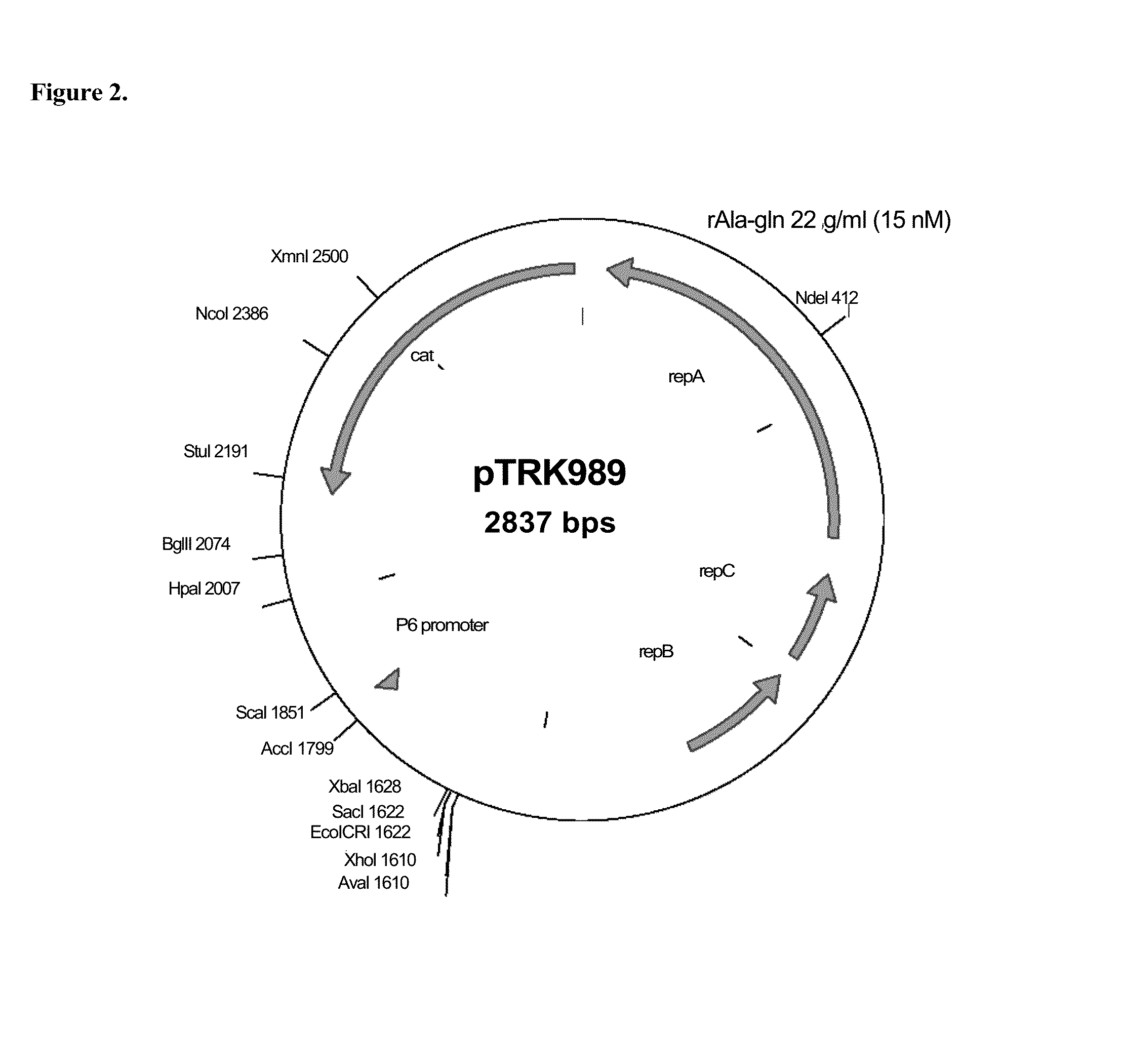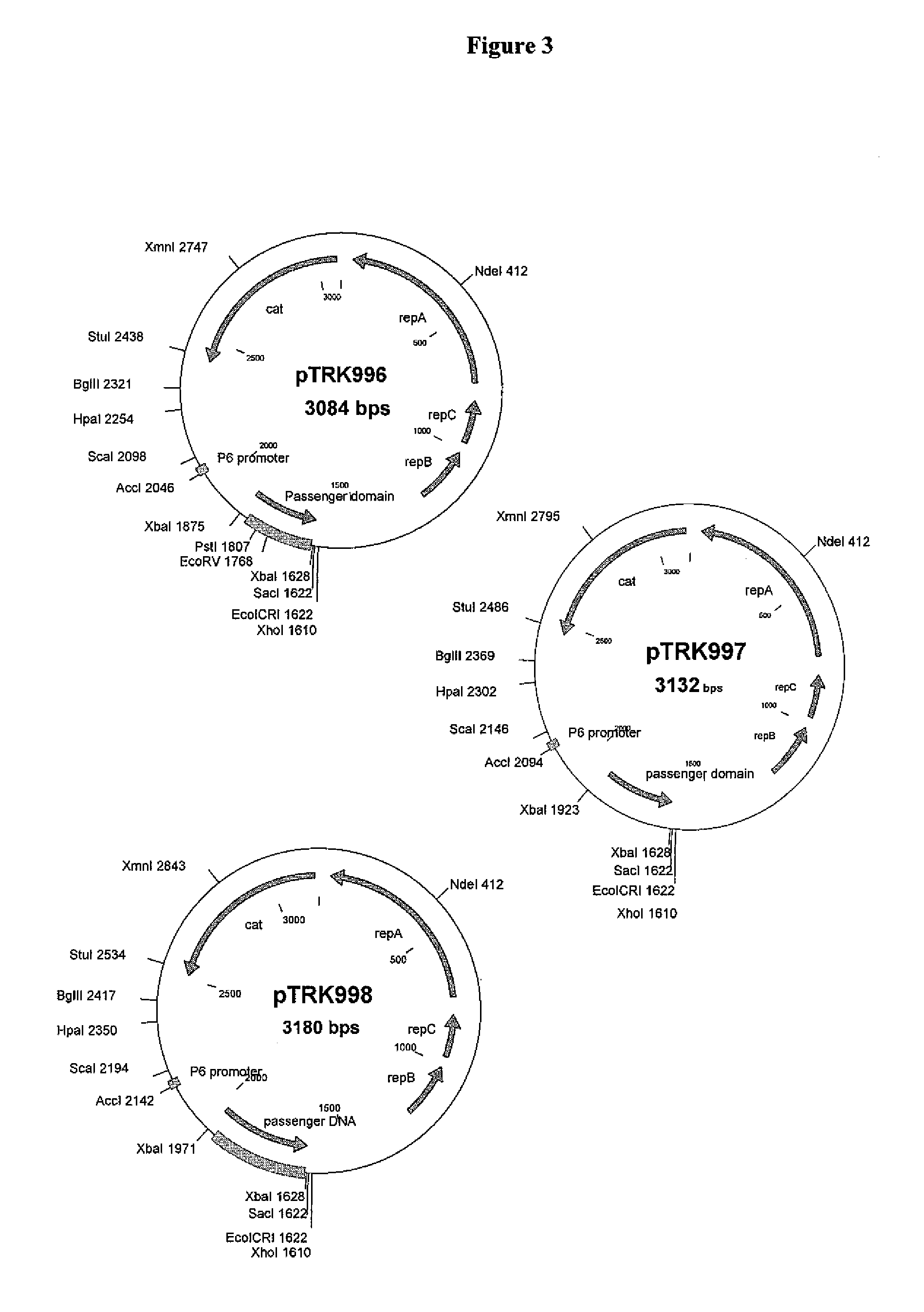Genetically modified Streptococcus thermophilus bacterium
a technology of streptococcus thermophilus and bacterium, which is applied in the direction of antibacterial agents, peptide/protein ingredients, and bacteria material medical ingredients, etc., can solve the problems of bile sensitive, intracellular protein release, permeabilization, etc., and achieve the effect of promoting the desired therapeutic response and reducing mucosal damag
- Summary
- Abstract
- Description
- Claims
- Application Information
AI Technical Summary
Problems solved by technology
Method used
Image
Examples
example 1
[0213]Plasmids pUC57-AGRP-FHO, pUC57-AGRP-FH1 and pUC57-AGRP-FH2 containing the Gln-rich oligopeptides AGRP-FHO, AGRP-FH1 and AGRP-FH2 were constructed by GenScript Corporation (Piscataway, N.J.) based upon the amino acid sequences of the Gln-rich passenger domains shown below (Table 1). Each of the three oligopeptides contains a FLAG-tag epitope (DYKDDDDK, SEQ ID NO: 13). The Table also contains information of the molecular mass and isoelectric point of the encoded Gln-rich oligopeptide. The coding regions of the passenger were used in the construction of the St. thermophilus expression vectors described below.
[0214]The Gln rich oligopeptides contained in plasmids pUC57-AGRP-FHO, pUC57-AGRP-FH1 and pUC57-AGRP-FH2 can be designed to improve stability by taking into account length, Gln content, and the presence of protease cleavage sites that might promote their degradation upon release. Other amino acids could be included in the Gln rich peptides, such as arginine that have shown sy...
example 2
[0216]St. thermophilus strain LMD-9 (also designated NCK1125) has a complete genome sequence (Makarova, 2006, Proc. Natl. Acad. Sci. USA, 103:15611-15616) and is genetically assessable by electroporation. This strain has been successfully used for cloning to a high copy vector (pTRK686) for elevated expression of antisense RNAs that were capable of retarding bacteriophage infection. In addition, the same base vector was used to express intracellularly, in trans, a phage primase that had been poisoned by a directed mutation. The vectors used to express the Gln-rich oligopeptide constructs were derived from pTRK686 and contain a multiple cloning site and a strong constitutive promoter that can be used to drive expression of the Gln-rich oligopeptide (See FIGS. 2 and 3).
[0217]The E. coli-gram positive shuttle vector pTRK989 was chosen for expression of the AQQ passenger sequences. Plasmid pTRK989 carries a strong P6 promoter, and is an XbaI-deleted derivative of pTRK696 used previously...
example 3
[0222]Streptococcus thermophilus (LMD-9) was grown in Elliker's broth supplemented with 1% beef extract at 42° C. for 18 h resulting in 109 CFU / mL. Cultures for use as an in vivo treatment were pelleted, washed, and resuspended in broth to a final concentration of 108 / mL. A clinical BI strain of Clostridium difficile (UVA24; TcdA+, TcdB+, CdtA / B+) or the historical strain, VPI10463 was used in the studies outlined below. C. difficile were grown in pre-reduced chopped meat broth for 18 h at 37 C for use in vivo or overnight in BHI broth for in vitro studies. C. difficile was enumerated on BHI agar containing 0.5% neutral red (1% w / v in ethanol) using the broth microdilution and the drop plate method (Chen, 2003, J. Microbiol. Methods, 55(2): 475-479).
PUM
| Property | Measurement | Unit |
|---|---|---|
| pharmaceutical composition | aaaaa | aaaaa |
| size | aaaaa | aaaaa |
| acid tolerant | aaaaa | aaaaa |
Abstract
Description
Claims
Application Information
 Login to View More
Login to View More - R&D
- Intellectual Property
- Life Sciences
- Materials
- Tech Scout
- Unparalleled Data Quality
- Higher Quality Content
- 60% Fewer Hallucinations
Browse by: Latest US Patents, China's latest patents, Technical Efficacy Thesaurus, Application Domain, Technology Topic, Popular Technical Reports.
© 2025 PatSnap. All rights reserved.Legal|Privacy policy|Modern Slavery Act Transparency Statement|Sitemap|About US| Contact US: help@patsnap.com



